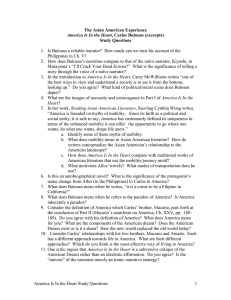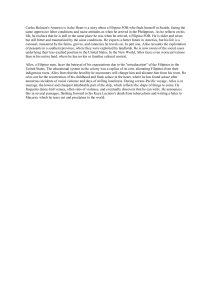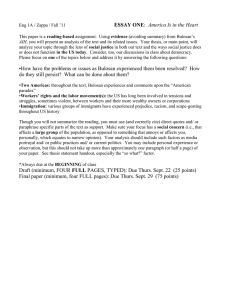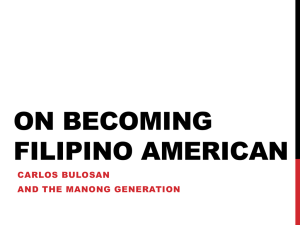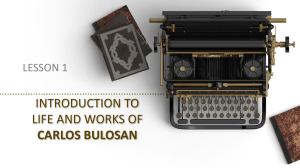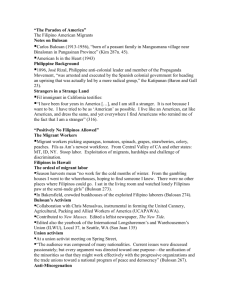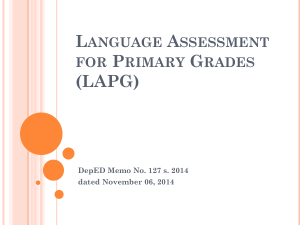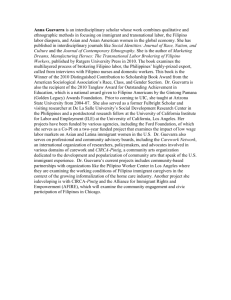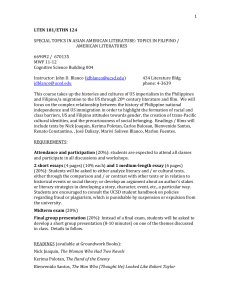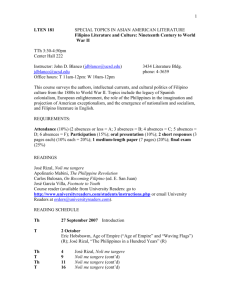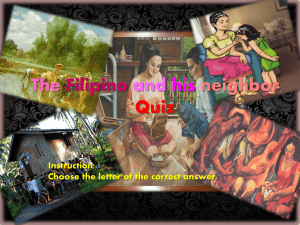lecture #6: America is in the Heart
advertisement
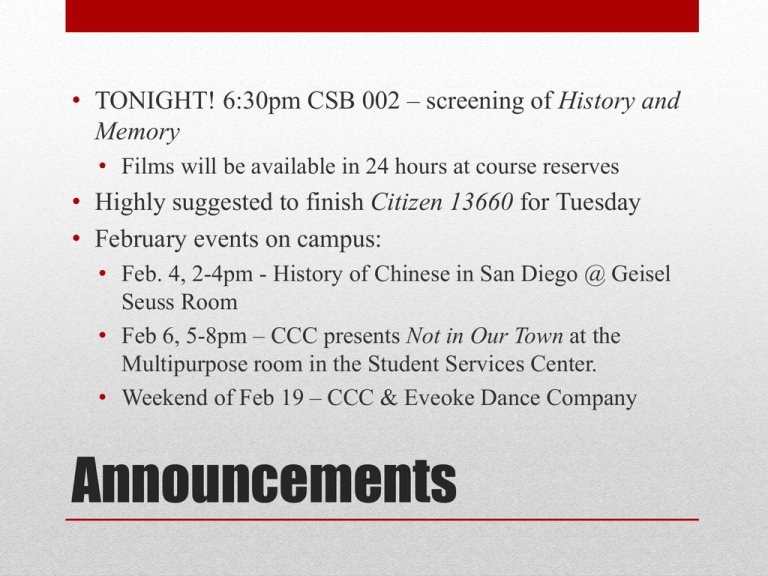
• TONIGHT! 6:30pm CSB 002 – screening of History and Memory • Films will be available in 24 hours at course reserves • Highly suggested to finish Citizen 13660 for Tuesday • February events on campus: • Feb. 4, 2-4pm - History of Chinese in San Diego @ Geisel Seuss Room • Feb 6, 5-8pm – CCC presents Not in Our Town at the Multipurpose room in the Student Services Center. • Weekend of Feb 19 – CCC & Eveoke Dance Company Announcements Filipino/American Lecture #6: Carlos Bulosan’s America is in the Heart • Nov 24, 1913 – born in the province of Pangasinan, Philippines • July 22, 1930 – arrived in Seattle • 1935 – started involvement in workers movement and labor organizing • UCAPAWA – United Cannery and Packing House Workers of America • • • • • 1936 – hospitalized for tuberculosis 1944 – Laughter of my Father 1946 – America is in the Heart 1950 – blacklisted for membership in CPUSA 1956 – died of tuberculosis in Seattle Carlos Bulosan • Genre - form of a text • Text - something that a society produces that one can analyze to learn about the very society that produced it. Ex: literature, visual art, film, music, etc • Autobiography – narrative of one’s life; backward glance from the present moment; implication of progress and linearity • Memoir – narrative of recollections from one’s life • Novel – imagined/fictional narrative of events and characters • Why would Bulosan transgress and blur genres? Autobiography? Memoir? Novel? • History or histories? Can anything ever be objectively told? • Ex: Philippine Insurrection vs Filipino American War • History versus memory In telling “history,” how do we insist on what is and is not remembered? • America is in the Heart = text • Author = Carlos Bulosan • Narrator = Allos histories & memory • Destruction of the family vs Hope in writing (56-57): • dispossession of the father • resilience of the mother yet tragedy of the sisters • arrivals and departures of the brothers Leon, Amado, Marcario, Luciano • Ch 1 connections between Leon & Allos as connection between US imperialism & Filipino immigration • Destruction of gendered bodies foreshadow violence against Filipino immigrant in US • Leon’s wife attacked because of lack of virginity (7) • Narrator witnesses prostitution in Manila right before his departure (93) Part 1: destruction & hope Descriptions of the process of racialization and its psychological repercussions: • P. 67 – the lady photographer in Baguio • P. 98 – “half-naked savages” • P. 121 – “it was a crime to be a Filipino in California” • Criminalization of his brothers • Changing of narrator’s name indicating effects of racialization Re-visioning America – Marcario’s speech (187) • America as epitome of civilization… • America as disembodied ideal… • America born from the efforts of the brutalized and marginalized… Part 2: racialization & re-visioning • The violence of hypersexualization • P. 208 – near lynching of narrator and Jose for labor organizing • Sacrificial & platonic love between Filipino and white women: • P. 209 – Marian • P. 68 – Mary Strandon • P. 235 – Alice & Eileen Odell • Narrator as Christ-like figure: • 261 – Marcario’s sacrifice Part 3: love & sacrifice “It came to me that no man – no one at all – could destroy my faith in America again… It was something that grew out of the sacrifices and loneliness of my friends, of my brothers in America and my family in the Philippines – something that grew out of our desire to know America, and to become a part of her great tradition, and to contribute something toward her final fulfillment. I knew that no man could destroy my faith in American that sprung from all our hopes and aspirations, ever.” (326-327) Which America is in his heart – the racist and marginalizing nation or the revolutionary vision? Why allow for ambiguity? Part 4: America is in the heart? • TONIGHT! 6:30pm CSB 002 – screening of History and Memory • Questions to consider: • Why does the director interweave Hollywood films and military propaganda with the oral testimonies of her family members? • How would you categorize the film? Is it a documentary? • Why does the image of her mother filling a canteen reoccur constantly? What does that image mean to the director? History & Memory
